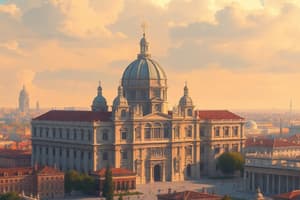Podcast
Questions and Answers
What historical factor often led to the change of capitals during the Medieval Period?
What historical factor often led to the change of capitals during the Medieval Period?
- Increase in economic power
- Translations of cultural texts
- Wars and treaties (correct)
- Population growth in existing capitals
Which ancient city is recognized for its political and religious significance as a capital in Mesopotamia?
Which ancient city is recognized for its political and religious significance as a capital in Mesopotamia?
- Nineveh
- Ur
- Sumer
- Babylon (correct)
Why did many countries move their capitals post-independence?
Why did many countries move their capitals post-independence?
- To reduce military presence
- To symbolize national unity (correct)
- To minimize cultural significance
- To increase tourist potential
Which modern capital was moved from a coastal city to a purpose-built city in 1960?
Which modern capital was moved from a coastal city to a purpose-built city in 1960?
What primary challenge do many contemporary capitals face today?
What primary challenge do many contemporary capitals face today?
Flashcards are hidden until you start studying
Study Notes
Capital Cities: Historical Background
-
Definition: Capital cities act as the official seat of government for a country or region, often housing key governmental institutions.
-
Origins:
- Historically, capitals were often located in central or strategic locations for defense and governance.
- Often developed from existing settlements or cities due to political significance or economic power.
-
Ancient Capitals:
- Mesopotamia: Cities like Babylon served as major capitals with political and religious significance.
- Rome: Became the capital of the Roman Empire, influential in law, governance, and culture.
-
Medieval Period:
- Capitals often moved due to wars, treaties, or royal decrees.
- Examples include Paris, which emerged as a cultural and political center in France.
-
Colonial Influence:
- European powers established colonial capitals in territories, often displacing indigenous centers.
- Capitals like New Delhi were built to symbolize colonial authority and governance.
-
Modern Developments:
- Many countries have moved their capitals post-independence to symbolize national unity or for strategic reasons.
- Examples:
- Brazil moved its capital from Rio de Janeiro to Brasília in 1960.
- Kazakhstan shifted its capital from Almaty to Nur-Sultan (formerly Astana) in 1997.
-
Impact of Geography:
- Some capitals are strategically located for trade, defense, or accessibility (e.g., Washington D.C. was chosen for its central location in the U.S.).
-
Cultural Significance:
- Capitals often reflect the national identity, history, and aspirations, serving as symbols of power and governance.
-
Contemporary Issues:
- Some capitals face challenges such as overpopulation, infrastructure stress, and political instability.
- Urbanization and globalization are influencing the role and function of capitals in the modern world.
Capital Cities: Historical Background
- Capital cities serve as the official seat of government, typically housing key institutions.
- Historically, capitals were sited in central or strategic locations for effective defense and governance.
- Many capitals evolved from existing settlements, gaining political or economic prominence over time.
Ancient Capitals
- Babylon in Mesopotamia was a significant capital, known for its political and religious importance.
- Rome emerged as the capital of the Roman Empire, shaping governance, law, and cultural development.
Medieval Period
- Capital locations frequently changed due to wars, treaties, or royal decrees.
- Paris became a central cultural and political hub in France during this era.
Colonial Influence
- European colonial powers often established new capitals in their territories, replacing indigenous centers.
- New Delhi was constructed to symbolize colonial rule in India.
Modern Developments
- Post-independence, several countries relocated their capitals to promote national unity or strategic advantages.
- Brasília became Brazil's capital in 1960, shifting from Rio de Janeiro.
- In 1997, Kazakhstan transitioned its capital from Almaty to Nur-Sultan (formerly Astana).
Impact of Geography
- Capital cities are often strategically positioned for trade, defense, or accessibility—for instance, Washington D.C. was chosen for its central U.S. location.
Cultural Significance
- Capitals reflect national identity and aspirations, representing symbols of power and governance.
Contemporary Issues
- Many capitals face challenges such as overpopulation, infrastructure strain, and political instability.
- Urbanization and globalization are reshaping the roles and functions of capitals in today's world.
Studying That Suits You
Use AI to generate personalized quizzes and flashcards to suit your learning preferences.




